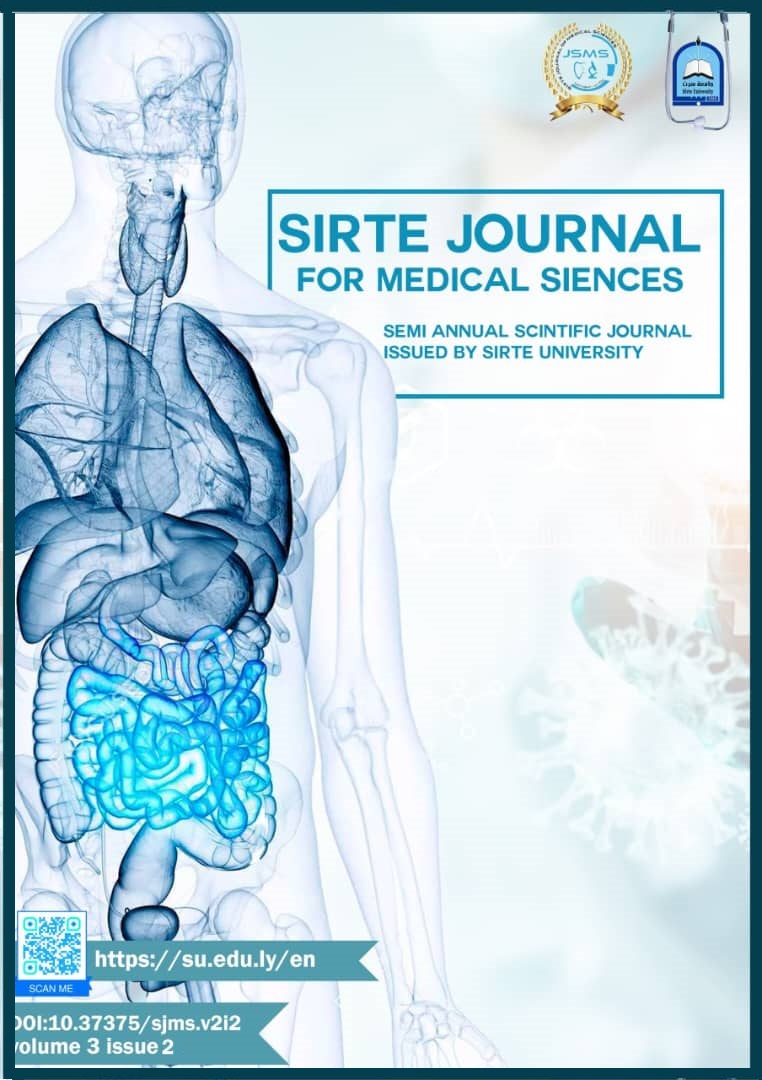Prevalence of Anaemia amongst non-pregnant women in Sirte at Ibn-Sina hospital over a period of ten years (2010-2020)
DOI:
https://doi.org/10.37375/sjms.v3i2.3175Keywords:
Anaemia, non-pregnant, Sirte, LibyaAbstract
Background: The World Health Organization (WHO) has reported that in 2019, 30% (539 million) of non-pregnant women were affected by anemia, with the highest prevalence in sub-Saharan Africa and Asia. Anaemia remains a major public health concern in developing countries, as it can affect individuals at any stage of life. The symptoms of anaemia are non-specific and can lead to reduced physical work capacity and productivity.
The aim of the study is to estimate the prevalence of anaemia in non-pregnant women residing in Sirte City.
Methods: This is a retrospective observational study that took place at Iben Sina Teaching Hospital in Sirte, Libya. The study included all case records of women above the age of 15 years who were admitted to the female medical ward at the hospital in the period between 2010 and 2020.
The data was examined using Microsoft Excel 2019 and presented in tables and graphs.
Results: The case records of 773 cases were reviewed and analyzed. The results revealed an estimated anemia (Hb <12g/dl) prevalence of 14.7% (114/773), the mean age of patients was 55 years and the mean Hb was 6.5 g/dl.
Conclusion:
The study showed that anaemia is prevalent in the admitted female population in the city of Sirte and a notable increase was noted in the last year of the study that could reflect capturing the real prevalence; this must be confirmed in subsequent studies that would also help in identifying risk factors and causes in this female population
References
Lancet Glob Health. 2022; 10: e627-e639) National, regional, and global estimates of anaemia by severity in women and children for 2000–19: a pooled analysis of population-representative data
1.Zhuo Wang, Yanjun Huang, Zhihua Zhou, Jian Huang, Yitong He, Pingming Qiu. (2022) Local iron deficiency in the substantia nigra directly contributes to hyperlocomotion phenotypes. Neurobiology of Disease 168, pages 105693.
1 Y. Balarajan, U. Ramakrishnan, E. Ozaltin, A. H. Shankar et al. “Anaemia in low-income and middle-income countries,” The Lancet, vol. 378, no. 9809, pp. 2123–2135, 2011.
K. Tolentino and J. F. Friedman, “An update on anemia in less developed countries,” The American Journal of Tropical Medicine and Hygiene, vol. 77, no. 1, pp. 44–51, 2007.
P. Bharati, S. Som, S. Chakrabarty, S. Bharati, and M. Pal, “Prevalence of anemia and its determinants among nonpregnant and pregnant women in India,” Asia-Pacific Journal of Public Health, vol. 20, no. 4, pp. 347–359, 2018.
M. E. Bentley and P. L. Griffiths, “The burden of anemia among women in India,” European Journal of Clinical Nutrition, vol. 57, no. 1, pp. 52–60, 2013.
Yichun Hu , Min Li, Jinghuan Wu, Rui Wang, Deqian Mao, Jing Chen, Weidong Li, Yanhua Yang,Int. J. Environ. Res. Public Health 2019, 16, 1290
7.T. Shamah-Levy, S. Villalpando, J. A. Rivera, F. Mejía-Rodríguez, M. Camacho-Cisneros, and E. A. Monterrubio, “Anemia in Mexican women: a public health problem,” Salud Publica de Mexico, vol. 45, no. 4, pp. S499–S507, 2003.
J. Haidar, “Prevalence of anaemia, deficiencies of iron and folic acid and their determinants in Ethiopian women,” Journal of Health, Population and Nutrition, vol. 28, no. 4, pp. 359–368, 2010.
Prevalence of anemia among women of reproductive age (% of women ages 15-49) - Libya. World Bank Open Data. (n.d.). https://data.worldbank.org/indicator/SH.ANM.ALLW.ZS?end=2019&locations=LY&start=2019&view=bar https://data.worldbank.org/indicator/SH.PRG.ANEM?skipRedirection=true&view=map











